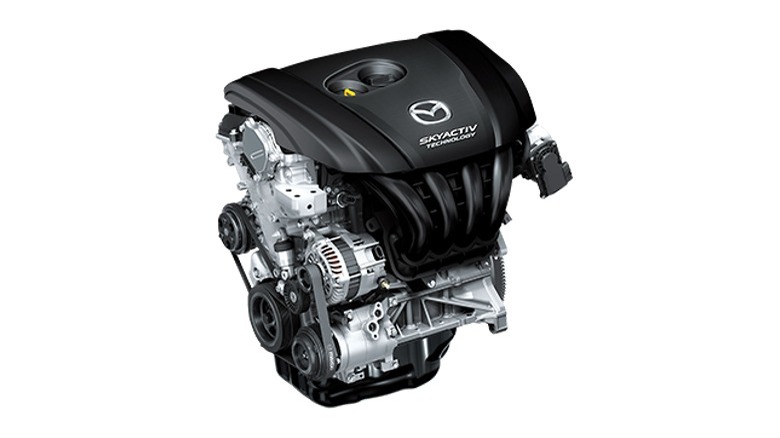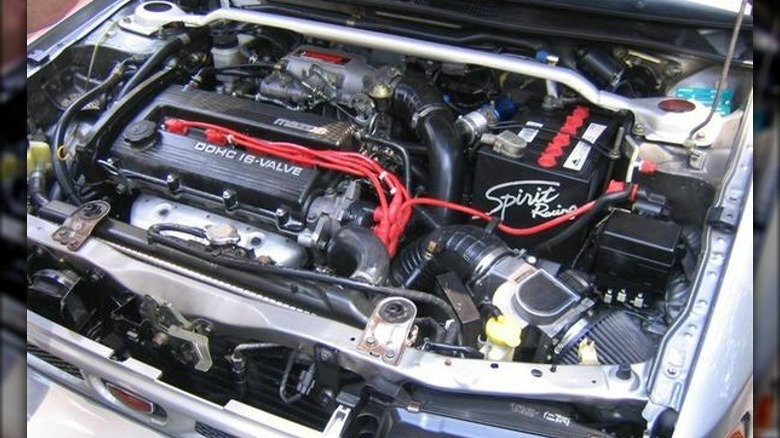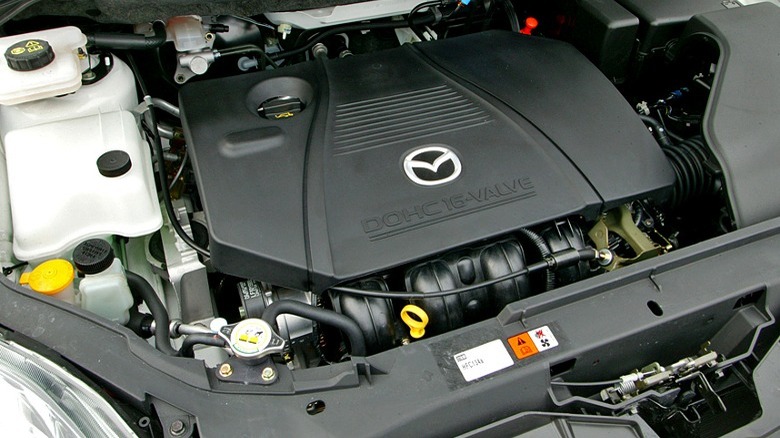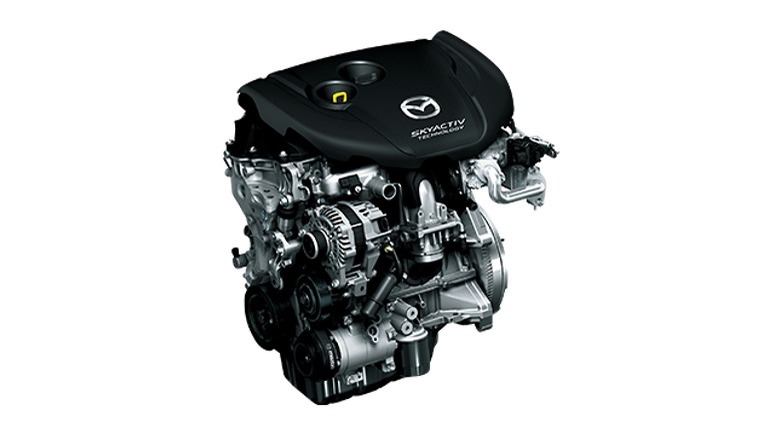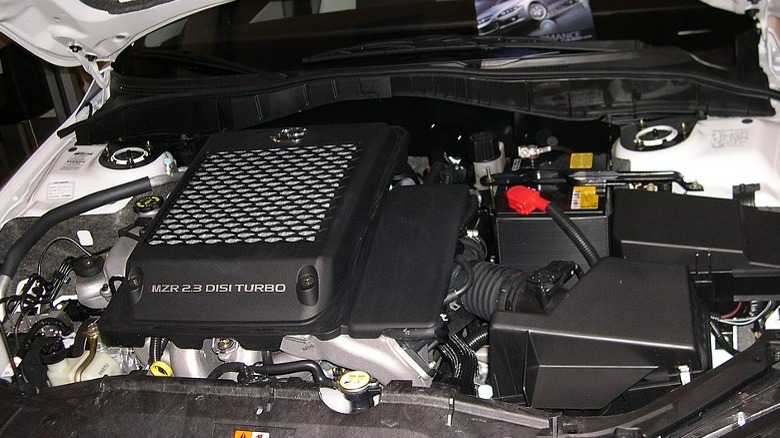5 Of The Most Reliable Mazda Engines Ever Made
Mazda has been building reliable automobiles for almost a century. Founded in 1920 as a cork manufacturer (originally Toyo Cork Kogyo) by Jujuro Matsuda, the business completed its transition into the automotive industry in the early 1930s with its first two-stroke engine prototype in 1929 and motorcycles in 1930. By 1931, Mazda three-wheel trucks marketed under the Mitsubishi moniker (and triple diamond logo) were hitting the market.
Throughout its history, Mazda has always taken great care to offer its users a durable vehicle they can count on. As such, many of the engines produced by Mazda are highly touted as reliable favorites among car enthusiasts. Not only are Mazda vehicles fun to drive, their engines can often be relied upon for hundreds of thousands of miles before needing a major replacement. With the average driver in America keeping hold of their car for around 12 years (and an average mileage of 13,500 per year), Mazda owners can afford to keep their beloved ride for longer and rack up the miles on lengthy commutes or road trips.
While Mazda products across the board are often known for their robust build quality, these five Mazda engines are a cut above the rest when it comes to longevity and reliability.
Skyactiv-G 2.5L Turbo
The Skyactiv-G engine is one of Mazda's most advanced powerplants. The engine is the first among mass-production units to achieve a compression ratio of 14.0:1, allowing the Skyactiv engine to offer a 15% improvement in torque output and fuel efficiency.
The Skyactiv-G 2.5L Turbo is the powerplant found in the high-performance Mazda CX-30s, a crossover SUV platform that looks and drives like perfection. The engine offers drivers as much as 250 horsepower and 320 lb-ft of torque, delivering a potent driving experience that may not be customary for most behind the wheel of a small crossover vehicle.
The Skyactiv technology suite was first introduced in 2010. The stable of engine and transmission products was designed to improve fuel efficiency and driving performance without compromising one for the other. The Skyactiv-G series engines (in a 2.5L Turbo build) are found in various Mazdas, including the CX-9, Mazda3, and the CX-30. The engine was first placed in the 2018 Mazda6 and has since grown alongside the brand's lineup. It's a fast-paced engine that remains a gasoline sipper, translating into a high-performance component that's immensely reliable on the road and under the hood.
The BP Engine
Mazda began producing the BP engine in 1989 and continued building these powerplants until 2004. They've been featured in a wide range of Mazdas, Kias, and the Suzuki Baleno. The BP engine produced between 130 and 140 horsepower and 150 to 160 Nm of torque (roughly 110.6 to 118 lb-ft). It was built as a cast iron block with a displacement of 1,839cc. This makes it a 1.8L engine –- small compared to some other Mazda powerplants but still masterfully robust regarding longevity and reliable performance output. These engines have a lifespan rating of around 205,000 miles.
One sub-type of the BP engine is the BP-ZE, featured in a range of cars throughout the 1990s. This subspecies of the Mazda BP powerplant was built with a forged crankshaft, among other things, and was the first Mazda engine to include the brand's VICS system (Variable Induction Control System). These features make it a reliable Mazda engine that can perform under various weather and landscape conditions without hesitation.
[Featured image by Strykr81 via Wikimedia Commons | Cropped and scaled | CC BY-SA 3.0]
The LF-DE engine (part of the L Series)
Mazda produced the LF-DE engine from 2002 and 2015, and the powerplant could be found in Asian builds for the Mazda3, Mazda5, and Mazda6, as well as several other Mazdas and Fords. The engine is rated for a lifespan of around 186,500 miles, placing it squarely above the average demand that a car owner will require. The LF-DE engines aren't turbocharged, but they still output roughly 140 to 160 horsepower and 175 to 195 Nm of torque (129 to 144 lb-ft).
The 2.0L (1,999cc) engine is an Inline Four layout built with an aluminum cylinder block. It's run with a 16-valve head and dual overhead camshafts. The light build (weighing only 231 pounds) and integrated technology make this L Series engine a reliable workhorse. The engine's emissions are minimized compared to many other engine models, and drivers who benefit from this engine installed in their car will also see noticeable fuel consumption savings. The engine is fuel-efficient while still providing the power necessary to accelerate around town or on the highway.
[Featured image by 天然ガス via Wikimedia Commons | Cropped and scaled | CC BY-SA 3.0]
The 2.2L Turbo-Diesel Skyactiv-D
Like other Skyactiv engines, the Skyactiv-D build is a sight to behold. The Diesel model keeps the same incredibly low compression ratio of its siblings at 14.0:1 –- the lowest compression ratio among any diesel engine in use. The Skyactiv-D also benefits from a turbocharger that offers a two-stage process, smoothing out engine performance across speed thresholds. These features make it a massively efficient power producer that's also 20% more fuel efficient as a result. Furthermore, the Skyactiv-D engine won't require NOx aftertreatments because it can suck in sufficient oxygen.
These Skyactiv-D engines are an Inline Four configuration measuring 2,191cc (2.2L), offering 173 horsepower and 310 lb-ft of torque. They're built with an aluminum cylinder block, reducing the unit's weight alongside the other efficiency statistics that factor into the engine's overall construction. Since 2012, Mazda has been installing 2.2L Skyactiv-D Turbo-Diesels in Mazda CX-5, Mazda6, and Mazda3 vehicles.
The 2.3L, MZR/L3-VE and DISI Turbo (part of the Mazda Responsive engine series)
Finally, the MZR engine series has to be on any Mazda enthusiast's radar. The 2.3L MZR engine is a workhorse in the series and offers an Inline Four build that utilizes an aluminum cylinder block for durability and weight reduction purposes. The engine was built between 2001 and 2010 and found its way into the Mazda3, Mazda5, and Mazda6, therefore featuring prominently within the brand's automotive lineup for much of the decade.
The engine provides a measured displacement of 2,260cc (2.3L), producing up to 164 horsepower and 154 lb-ft of torque. Alongside the standard MZR engine, Mazda offered a 2.3L DISI Turbo build between 2005 and 2012 that was installed in the Mazdaspeed6 (and later the CX-7 and Mazdaspeed3). The turbocharged variety boosted power output to 263 horsepower and 280 lb-ft of torque. Both engines provide drivers with significant power output while also bringing the signature Mazda engineering chops to bear. This makes them an excellent option when a blend of high-performance output and longevity is required.
[Featured image by Sfoskett via Wikimedia Commons | Cropped and scaled | CC BY-SA 3.0]

